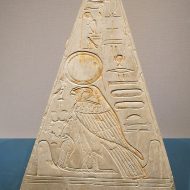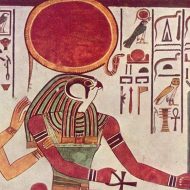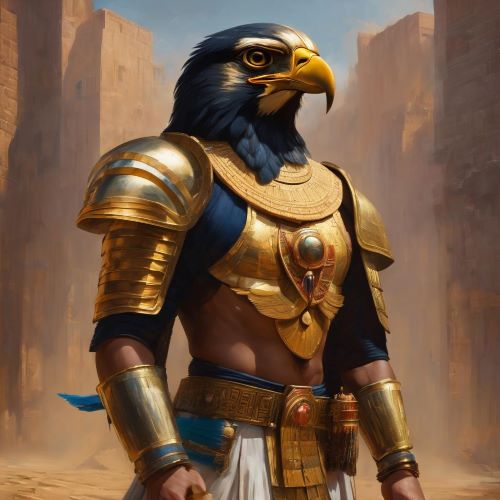Ra : The Sun God
Listen
At a glance
| Description | |
|---|---|
| Origin | Egyptian Mythology |
| Classification | Gods |
| Family Members | Bastet (Daughter), Hathor (Daughter) |
| Region | Egypt |
| Associated With | Sun, Life, Agriculture |
Ra: Egyptian Sun God
Introduction
Ra was the Egyptian God of the sun. He was worshipped in all parts of the ancient world, and during the 5th Egyptian Dynasty, he was identified with the noon-day sun and was considered to be a god of the underworld.
Ra was portrayed as a falcon with characteristics similar to the sky-god Horus. The Mnevis bull cult had its center in Heliopolis. There was a burial ground for the bulls north of the city.
Various accounts indicate that humans were created from the tears and sweat of Ra and the Egyptians call themselves the Cattle of Ra.
Physical Traits
He was often depicted with the head of a falcon, a solar disk, or a coiled serpent around the disk. Other common forms include a man with the head of a beetle, or a man with the head of a ram. He was also pictured as a full-bodied ram, beetle, phoenix, heron, serpent, bull, cat, or lion, among others.
He was most commonly depicted with a ram’s head. In this form, he is referred to as a harem’s head or a ram of the west. In some literature, Ra is described as an aging king with golden flesh, silver bones, and hair of lapis lazuli.
Family
As with most widely worshiped Egyptian deities, Ra’s identity was often combined with other gods’, forming an interconnection between deities.
Amun was a creation-energies member of the Ogdoad. He was believed to create by breath, and thus was identified with the breeze instead of the sun. As the cult of Amun grew more popular, it was combined with the cult of Ra to create Amun-Ra. This god was given the title King of the Gods by worshippers.
Atum-Ra was a composite deity that was formed from two separate deities, Amun and Ra. It was more closely linked to the sun than to the other deities, and was widely worshipped. Ra-Horakhty was a title or concept that was used to refer to a deity other than a composite deity. It was suggested that Ra-Horakty represented the sun’s journey from the horizon to the horizon, or that it meant to show him as a symbol of hope and rebirth.
As a scarab beetle, Khepri was often seen as the morning manifestation of Ra. Khnum, on the other hand, was the evening manifestation of the king. The idea of varying the deities’ ruling over different times of the day was fairly common.
Bastet is the daughter of Ra and is associated with the sun-god’s eyes. She is known for killing the serpents to protect him. In one myth, she was sent as a lioness to protect him. Sekhmet is the daughter of Ra and is depicted as a large cat with an eye of the sun god. In one myth, she was so enraged that he had her turned into a cow so that she could not cause any harm. In another story, Ra sends Hathor, another daughter, to punish humanity for plotting against him. When he saw that mankind was plotting against his, he sent her as an eye of Ra. When he was without Hathor, he suffered from deep depression.
Most of the Old Kingdom’s pyramids do not mention Ptah. Some believe that this is due to the people of Heliopolis worshipping the god of chaos. Others believe that he was created by Ptah.
Powers and Abilities
The sun is the giver of life, which means it controls the ripening of crops. Egyptians worshipped the sun as a god and in turn Ra, as he represented life, warmth, and growth. During an early period in Egyptian history, the influence of this god spread throughout the country. His various forms are represented by Atum, Khepri, and Horus.
On top of his head is a solar disc, and it represents the eye of Ra. During the beginning of time, the sun-god was alone in the universe, and he would later begin ruling over the Earth. He created Shu and Tefnut, the goddess of air and moisture, respectively. Human beings were believed to have been created by saying their secret names.
One myth states that Earth got its name from the water that flowed from Nun. In the story of the Celestial Cow, the sun god summoned it from the depths of Nun and told Ra how he sent his eye to punish people. It was also believed that Hathor, Sekhmet, and Bastet were the Eye of Ra.
He was believed to travel on two solar barques known as the Mandjet and the Mesektet. These boats took him on his way through the sky and the underworld, which is also referred to as the 12 hours of night. While on the Mesektet he was accompanied by various deities, such as Heka and Sia.
The god of chaos, Apophis, was an enormous serpent that tried to stop the sun-boat’s journey. During the night, Egyptians believed that Ra would appear as a ram and carry him through the underworld to the east.
Check out how RA creates the universe here
Worship
The centre of Ra was Iunu, which was later known as Heliopolis. It was located in the suburbs of Cairo and was associated with Atum-Ra, the local sun god. There were also other cultic centres of Ra, such as Setubal and Gebandnut.
The cult of Ra began to grow during the Second Dynasty. By the Fourth Dynasty, his worship was widely considered as that of the Son of Ra, and when he became a state-deity, his followers worshipped him with special monuments and temples. During the Middle Kingdom, Ra was increasingly affiliated and combined with other chief deities, especially Amun and Osiris.
During the time of the New Kingdom, the worship of Ra became more elaborate and grand. The walls of his tomb were dedicated to detailed texts that depicted his journey through the underworld. Many acts of worship included hymns, prayers and spells to help Ra and the sun-boat overcome Apep. The rise of Christianity in the Roman Empire put an end to the worship of Ra.
Related Images
Frequently Asked Questions
What was Ra the god of?
Ra, also known as Re, was the ancient Egyptian deity of the Sun. Ra ruled in all parts of the created world. He was believed to have ruled as the first Ancient Egypt. He was the god of the sun, order, kings, and the sky.
Is Ra god a female?
Ra, the ancient Egyptian deity of the Sun, is typically portrayed as a male figure. He is often depicted as a man with the head of a falcon, adorned with a sun disk.
Who is the wife of Ra?
In ancient Egyptian mythology, Ra, the Sun god, is sometimes thought to be married to Hesat or Hathor, although the latter is usually referred to as his daughter. However, Ra never had a single wife in the story of mythology.
Does Ra have a son?
Yes, Ra does have children in some stories. His children are Shu, the god of dry air and father of the sky, and his twin sister Tefnut, the goddess of moisture and wetness.
Sources
Wikipedia: Ra – Wikipedia
Britannica: Ra | Egyptian God – Britannica
“The Complete Gods and Goddesses of Ancient Egypt” by Richard H. Wilkinson – Thames & Hudson
“Egyptian Mythology: A Guide to the Gods, Goddesses, and Traditions of Ancient Egypt” by Geraldine Pinch – Oxford University Press
Ra: Sun God of Ancient Egypt – ResearchGate
Egyptian Mythology Study Material – Google Books
Journal of Egyptian Archaeology: Articles on Ra – University College London














